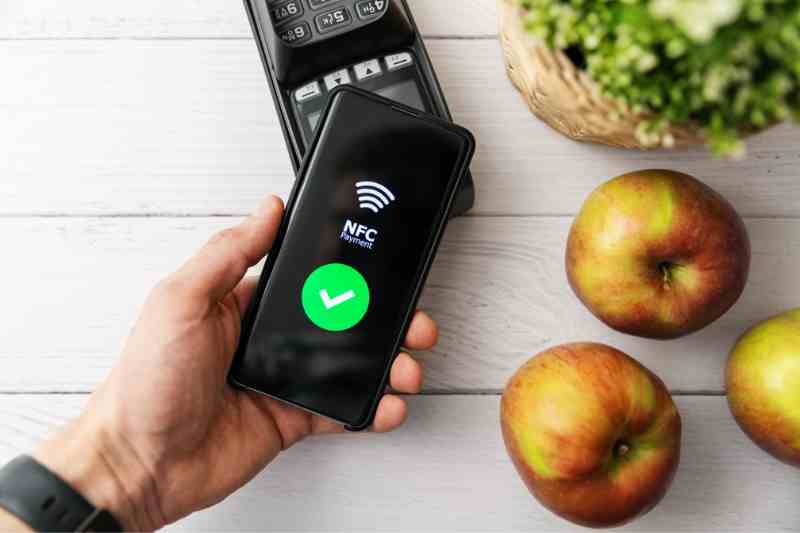Key takeaways
- NFC tags in real estate are a form of wireless technology that allows close-range devices to communicate with each other.
- Real-world uses of NFC tags in real estate include access control, contactless payments, and virtual apartment touring.
- The benefits of NFC tags in real estate are that they enable contactless payments, access control, virtual tours, and enhance the leasing process.
- The cons of NFC tags in real estate are that they only work in short-range, are power-dependent, have a limited storage capacity, and can be susceptible to wear and tear.

NFC tags in real estate are small but powerful assets that offer a range of tech-forward applications, from access control to contactless payments. So, it’s no surprise that NFC tags have emerged as a valuable tool in real estate marketing.
Read on to learn what NFC tags in real estate are and how they work. Then, explore the benefits and drawbacks of NFC tags in real estate marketing.
This post covers:
- What is NFC in real estate?
- How does an NFC tag work?
- Pros and cons of NFC tags
- NFC tags in real estate FAQ
What is NFC in real estate?
NFC (near-field communication) tags are a form of wireless technology that uses radio waves to facilitate communication between close-range devices.
They’re small, unobtrusive devices that can be embedded in various objects. So, they can be used in a wide range of industries due to their affordability, flexibility, and convenience.
What’s more, NFC tags in real estate act as a bridge between physical and virtual spaces while enhancing prospects’ leasing experience.
What are NFC tags used for?
NFC tags have various uses, from enabling contactless payments to launching virtual apartment tours. Moreover, an NFC-enabled smartphone empowers prospects to use their phone as an NFC key fob for keyless access.
These devices are also powerful because they offer a seamless way to exchange data.
For instance, interested property prospects can tap their smartphone on a strategically placed NFC tag on a leasing sign or flyer. This empowers a prospect to automatically receive valuable information, like pricing, property features, square footage, community amenities, and more

How does an NFC tag work?
NFC tags use RFID (radio-frequency identification) technology to communicate between close-range devices. To do this, an NFC reader communicates with the NFC tag like a smartphone or any NFC-enabled device.
Additionally, all NFC tags are embedded with a microchip to store data and facilitate communication with the NFC reader. Moreover, this microchip can store various data like URLs, contact and payment information, and more.
Pros and cons of NFC tags in real estate
NFC tags in real estate offer several advantages and drawbacks.
Read on to discover the pros and cons of implementing this wireless technology into your real estate marketing strategy.
Benefits of NFC tags in real estate
Here are some advantages of NFC tags in real estate:
- Access control. In properties, NFC key fobs are used to facilitate contactless access control. To do this, a resident places their NFC-enabled smartphone near a reader for automatic access. However, a more robust access control solution is needed if you want to implement NFC access control in long-distance applications, like enabling automatic vehicle access.
- Virtual apartment tours. Looking for modern self-showing technology? If so, NFC tags are often used to enable virtual apartment tours. With this purpose in mind, NFC tags can be embedded with URLs that lead to a dedicated webpage or mobile app. So you can use these pages to host virtual tours. You place the NFC tag in a key property location, like a room, amenity space, or another point of interest. Then, prospects tap the tag with their NFC-enabled smartphone to launch a virtual tour automatically on their device.
- Contactless payments. Processing contactless payments is one of the most common ways NFC tags are used. For this reason, they’re an invaluable tool for processing payments in real estate.
- Enhance the leasing process. NFC technology is often used to track who’s accessed certain information. With this in mind, send follow-up emails to prospects who have used NFC tags to learn more about your property. As a result, NFC tags offer a convenient way to track leads in real estate and move prospects through your marketing funnel.
Drawbacks of NFC tags in real estate
- Limited range. NFC tags are designed to be used in close range. So, they’re not ideal for long-distance applications.
- Dependent on power supply. NFC tags require a stable power supply to function. So, they won’t work in an outage without a battery backup.
- Limited storage capacity. Because NFC tags have a limited power supply, they’re not ideal for extensive or large-scale properties.
- Susceptible to wear and tear. NFC tags may lose efficacy over time when used in high-traffic areas.
Learn how ButterflyMX works:
NFC tags in real estate FAQ
Here are some frequently asked questions about NFC tags in real estate:
- How much do NFC tags in real estate cost?
- Can NFC tags be tracked?
- How do I use my phone as an NFC tag?
- How long do NFC tags last?
How much do NFC tags in real estate cost?
Individual NFC tags are very affordable. Depending on their specifications, they typically cost between $0.10 and $0.60 per tag.
Can NFC tags be tracked?
While NFC tags don’t have built-in tracking technology, when an NFC tag is read, it can be tracked or logged by the device initiating the communication.
How do I use my phone as an NFC tag?
To use your phone as an NFC tag, adhere an NFC tag to your smartphone so that it can be used as an NFC key fob.
However, a more robust solution, like a mobile access control system, empowers prospects to use their smartphone as an NFC key fob without needing to adhere to any physical tags.
Moreover, these systems empower residents to share Visitor Passes to grant autonomous access to service providers, delivery couriers, guests, and more.
How long do NFC tags last?
In low-traffic environments, NFC tags can last up to 10 years.







